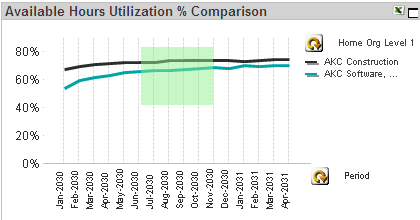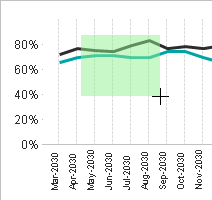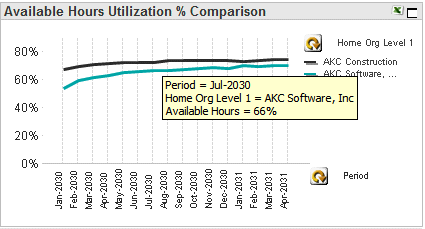Direct or Available Cost or Hours Utilization % Comparison Chart
|
Chart Item
|
Description
|
|
Horizontal axis: analysis period
|
The horizontal axis displays the fiscal period of the analysis period used in the comparison.
|
|
Vertical axis: current value
|
The vertical axis displays the current value for the utilization that you are comparing.
|
|
Trend lines
|
Each colored trend line represents a utilization percentage. Current period utilization displays as solid lines.
By default, this chart displays trend lines for level 1 home organizations. However, you can use  to change the attribute for which you analyze utilization. to change the attribute for which you analyze utilization.
|
The following data displays on this chart.
|
Data Item
|
Description
|
|
Direct or Available Hours or Cost
|
The chart displays the direct or available hours or costs utilization % for the analysis period.
For descriptions of the sources of the data used in labor utilization, see Data Sources.
|
There are two ways to view the type of labor used: Available
or Direct. These options
impact the Utilization % Analysis and the Utilization % Comparison charts.
Direct labor utilization is based on total labor, while available labor
utilization subtracts employee leave from the total labor. These options
ensure that you can track the efficiency of your labor force.
Labor type defaults to Direct
, but you can switch the type at any time.
To switch the type of labor...
Locate the labor type options.

Click Available or Direct. The selected option's button
turns green, and the pertinent information on the charts updates to
reflect your selection.
You can select different ways to view labor utilization: by Cost
or Hours, and by Period
or Year-to-Date (YTD).
Cost or Hours
Cost allows you to view
the total cost of labor utilization while hours only allows you to
view the number of hours charged. These options ensure that each employee
can only access the appropriate labor information.
Your security rights
determine access to select Cost
or Hours. Your system administrator
may configure your application to only allow Hours.
Contact your system administrator for further information.
Direct labor utilization
defaults to Hours when used
initially, but you can switch the chart type at any time.
Period or YTD
Period is data for the
current analysis period while YTD provides a cumulative, rolling perspective
within a given year. For example, February = January + February, March
= January + February + March, and so on.
Labor Utilization defaults
to YTD when used initially,
but you can switch the chart type at any time.
To switch the labor utilization view...
Locate the Utilization % Based
On options.

Click Cost or Hours. The selected option's button
turns green, and the pertinent information on the charts and tables
updates to reflect your selection.
Click Period or YTD. The selected option's button
turns green, and the pertinent information on the charts and tables
updates to reflect your selection.
By default, this chart displays the labor utilization by top-level organization or reorg, depending on your User Options selection, but you have the option to display the data by any of the following:
To change the view, do either of the following:
After you
select the view, you can select the associated time period. Use  below the grid to select the
length of time —
Period, Quarter,
or Year — for which you want to view the
data.
below the grid to select the
length of time —
Period, Quarter,
or Year — for which you want to view the
data.
If you apply filters before you
change the view, the chart only displays data for items that satisfy those
filters. For example, if you select two filters and then use  to display by manager, the table only displays the manager for those employee
attributes.
to display by manager, the table only displays the manager for those employee
attributes.
If the time period extends beyond the current period, the chart displays
projections by including Baseline or Forecast data as a dotted line. This
depends on the Budget Type option
selected on the User
Options tab.
Click  at the top right of the chart
to display the chart at its maximum size. Click
at the top right of the chart
to display the chart at its maximum size. Click  to restore the chart to its original size and location on the tab.
to restore the chart to its original size and location on the tab.
To focus the chart on a particular set of data points, click and drag the mouse pointer over the chart so that all of those data points are included in the green selection area.
 Illustration
Illustration
To focus the chart on one or a few attributes, click and drag the mouse pointer over the chart legend so that the green selection area touches only the information you want.  Illustration
Illustration
To focus the chart on a more restricted analysis period, do either of the following:
-
Specify the analysis period using the analysis period bars at the top of the tab.  Illustration
Illustration
-
Click and drag the mouse pointer over the chart so that the green selection area touches only the chart line data points for the fiscal periods you want to include.  Illustration
Illustration
It is much easier to make selections on the chart itself if you first maximize the chart.
If you use any of the above actions to change the chart, Costpoint Analytics applies the same changes, as appropriate, to all other analytic objects.
To see the information as of a specific fiscal period, position the mouse pointer over the utilization's trend line that coincides with the vertical grid line for the period. When you do, Costpoint Analytics displays the labor utilization in a data box.
 Illustration
Illustration
It is much easier to position the mouse pointer over a data point if you first maximize the chart.
Click  to send the data underlying
the chart to Microsoft Excel. More...
to send the data underlying
the chart to Microsoft Excel. More...
![]() to change the attribute for which you analyze utilization.
to change the attribute for which you analyze utilization.



